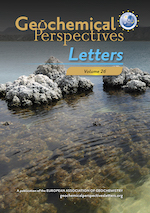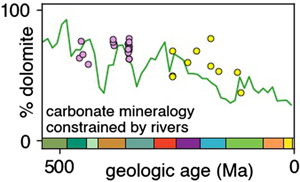 | River chemistry reveals a large decrease in dolomite abundance across the Phanerozoic Abstract: The abundance of dolomite in ancient carbonate sediments, and its apparent rarity today, has important implications for the coupled Ca-Mg-C-cycles in seawater and global climate. Despite its importance, there are large differences between published records of dolomite abundance vs. geologic age, mainly due to complexities in adequately sampling heterogeneous bedrock. We overcome this issue by using dissolved Mg2+ and Ca2+ measurements in rivers draining carbonate-bearing bedrock. Because rivers weather broad areas, this approach integrates the geochemical composition of much larger volumes of carbonate compared to sample based methods. The average Mg/(Ca + Mg) molar ratio in rivers declines with decreasing bedrock age, from 0.44 at ∼485 million year old (Ma) to 0.14 at ∼5 Ma, suggesting a decreasing percentage of dolomite in carbonate sequences across the Phanerozoic Eon. These data are hard to reconcile with any model that relies only upon oscillatory drivers to explain the dolomite abundance record, such as sea level or episodic expansions of ocean anoxia, and have important implications for the oceanic Mg cycle. |
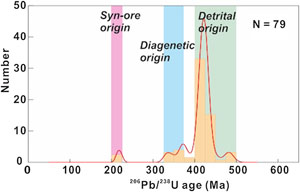 | Final assembly of Gondwana enhances crustal metal (HREE and U) endowment Abstract: The South China Block hosts a variety of U and HREE mineralisation styles. The Yushui Cu deposit is located at a sedimentary unconformity and is enriched in HREEs and U. U-Pb ages of uraninite and xenotime indicate that the HREE mineralisation is epigenetic and formed at ca. 223 ± 1 Ma. Ore petrography, elemental mapping, and Nd isotope data suggest that HREEs and U were leached from the footwall sandstone and transported to the Cu deposit via oxidised basinal brines. U-Pb ages of detrital xenotime and zircon from the sandstone show that this sedimentary sequence was mainly derived from Silurian S-type granites, which were emplaced during Gondwana amalgamation. Rapid erosion formed clastic sedimentary rocks that contain accessory HREE-U minerals which could be remobilised by younger mineralising events. S-type granite magmatism during the final assembly of Gondwana established the crustal metal reservoir which was repeatedly tapped over geological history, including the modern formation of regolith hosted HREE deposits in South China. Given the global distribution of analogous S-type granites in other terranes globally, our study has exploration implications outside of China. This will be enlightening for finding new HREE deposits, which is vital to support the transition to a low carbon footprint energy. |
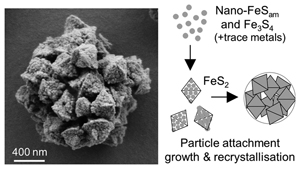 | Inferred pyrite growth via the particle attachment pathway in the presence of trace metals Abstract: The morphology of pyrite has been used to infer ancient redox states and biogenicity. However, the influence of trace metals on pyrite morphology is poorly understood. Through batch synthesis experiments, we demonstrate that bioessential trace metals (Co, Cu, Mo, Ni, Zn) accelerate pyrite formation. The first precipitate, FeSam, transformed to an intermediate greigite phase and to pyrite with increasing time and temperature. Trace metals either facilitated polysulphide formation or precipitated as nanoparticles that can serve as nuclei for pyrite growth, depending on the initial metal concentration. Despite varying precipitation rates, the final pyrite morphologies were unaffected. Various morphologies including tabular precipitates (<150 nm), aggregates resembling microframboids (100–250 nm), octahedral (300–1500 nm) and rose-like particles (1000–3000 nm) were observed. This size–shape particle continuum was interpreted as stages of pyrite growth via particle attachment. This process could be important in explaining variations in the mineral’s reactivity (e.g., defects), isotopic and trace metal distributions, and morphologies (e.g., framboids) for applications in paleo-proxies, environmental research and biosignatures. |
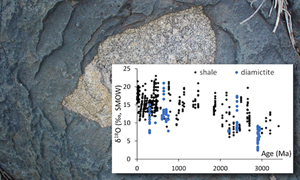 | Earth’s first glaciation at 2.9 Ga revealed by triple oxygen isotopes Abstract: We here report the lowest (∼3 ‰ VSMOW) δ18O values for any weathering-related sedimentary rock in Earth’s history, from shales and diamictites of the Mesoarchaean Pongola Supergroup of South Africa. This volcano-sedimentary succession was deposited in a shallow epeiric sea on continental crust of the Kaapvaal Craton and includes the record of the Earth’s oldest surface glaciation. Oxygen isotope data of shales of the Mozaan Group indicate gradual climatic cooling of the surface environments that culminated in glacial conditions at ∼2.90 Ga. Mathematical inversion of measured Δ'17O and δ18O values results in δ18O values around −20 ‰ for weathering waters, suggesting cold climate conditions. These observations suggest continental weathering of the Kaapval Craton involving low δ18O meteoric waters, possibly in a near-polar position. |
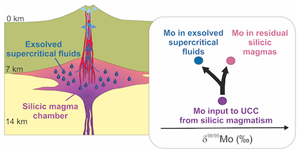 | Fluid-melt Mo isotope fractionation: implications for the δ98/95Mo of the upper crust Abstract: The isotopic composition (δ98/95Mo) of the modern upper continental crust (UCC) remains uncertain. A UCC estimate modelled from the δ98/95Mo of igneous rocks does not converge with constraints derived from the δ98/95Mo of magmatic-hydrothermal molybdenite (MoS2), a mineral used as a proxy for UCC lithologies. To shed light on this discrepancy, we experimentally determined equilibrium Mo isotope fractionation values between exsolved fluids and melts (Δ98/95Mofluid-melt) in shallow felsic magmatic systems. We show that light Mo isotopes are preferentially incorporated in aqueous supercritical fluids in equilibrium with silicic melts, with Δ98/95Mofluid-melt ranging from −0.43 ‰ to −0.17 ‰. The δ98/95Mo of exsolved fluids equilibrated in upper crustal silicic reservoirs should therefore be lighter than co-existing silicic melts. Since felsic plutonic rocks make ∼50 % of the UCC, estimates of UCC δ98/95Mo entirely based on igneous rock compositions or based on minerals (MoS2) growing in magmatic-hydrothermal systems alone will lead to divergent values. Our results can therefore explain the discordance between current UCC δ98/95Mo constraints and provide new ones, representing a key step toward the determination of a robust estimate. |
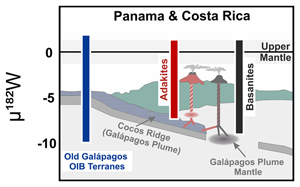 | Ancient mantle plume components constrained by tungsten isotope variability in arc lavas Abstract: Tungsten isotope anomalies in modern rocks are exclusively associated with plume-related basalts and may provide a unique tool to identify recycled plume material in subduction zone magmatism. In Central America, the Cocos and Coiba Ridges are subducting with the Cocos plate. These ridges may introduce material into the arc magma source that was derived from the Galápagos plume, which has been shown to carry anomalous 182W signatures. Here, we report negative μ182W values together with trace element data for <5 Ma old adakites and back-arc basanites, as well as accreted basalt terranes that formed as a result of Galápagos plume activity in the last 70 Myr. In adakites and basanites, these μ182W deficits derive from a slab melt component that dominates the W budget of their source. In addition, negative μ182W in accreted mafic terranes attest to the longevity of the primordial W isotope signature in the Galápagos plume and the involvement of a Galápagos-related magma source in the Central American arc system over time. |
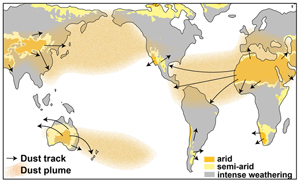 | Dust transport enhanced land surface weatherability in a cooling world Abstract: The weatherability of exposed silicate rocks drives the efficiency of climatic feedback on the geological carbon cycle through silicate weathering. However, the controls and evolution of land surface weatherability are not fully understood. Tectonically induced exposure of fresh silicates can induce a wide range of weatherability, depending on the maturity and lithology of the exhumed rocks. Here, we propose that aeolian dust has potentially been pivotal in sustaining land surface weatherability during global cooling. Our analysis of palaeoclimate simulations shows an additional transport of 1072 ± 69 Tg yr−1 of dust to regions with precipitation of more than 400 mm yr−1 during the Last Glacial Maximum compared to the pre-industrial period. As dust mainly contains fresh minerals with high surface areas, such dust transport markedly increases land surface weatherability, yielding an additional atmospheric CO2 consumption of 0.431 ± 0.030 Tmol yr−1, which would offset the reduced silicate weathering induced by weaker climatic forcing. It is suggested that a dustier world could increase global land surface weatherability, leading to a more buffered carbon cycle that sustained low atmospheric CO2 levels. |
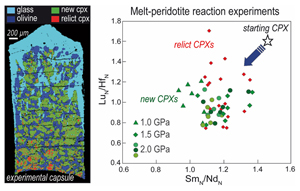 | Fast REE re-distribution in mantle clinopyroxene via reactive melt infiltration Abstract: Melt-mineral interactions may strongly affect the mineralogy and chemistry of the upper mantle. Although the grain-scale processes governing the interaction have been theoretically investigated, the efficiency of melt-rock reaction in re-distributing trace elements in mantle clinopyroxene still remains to be experimentally evaluated. We performed high pressure reaction experiments at 1–2 GPa, 1200–1350 °C, on homogeneous mixtures of LREE-depleted clinopyroxene, San Carlos olivine and an Enriched-MORB glass. Melt-peridotite reaction leads to textural replacement of mantle clinopyroxene by dissolution and precipitation as a function of temperature and run duration. Experimental results indicate that rapid modification of the REE signature of mantle clinopyroxene occurs not only via dissolution and precipitation but even via trace element diffusion within unreacted crystal relicts. The extent of reacted melt crystallisation influences the REE fractionation in modified clinopyroxene. Aided by a high reaction rate, local chemical equilibrium between clinopyroxene and melt can be approached even at the time scale of the experiments. Results from this study demonstrate that infiltration of REE-enriched melt within a mantle peridotite is capable of completely resetting the pristine trace element budget of mantle clinopyroxene. |
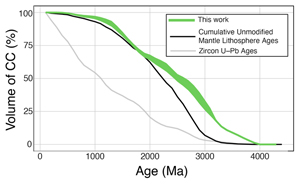 | A whole-lithosphere view of continental growth Abstract: Continental crust is a defining feature of Earth; yet, the mechanisms that control its growth remain hotly debated. Many approaches to estimating crustal growth focus solely on a single mineral—zircon, while constraints from the lithospheric mantle root remain largely neglected. Here, we critically examine the ability of zircon to accurately record the relative roles of juvenile crustal addition versus recycling, and present an alternative approach based on the geochemistry of crustal rock samples. The resulting model of continental crustal growth parallels, but pre-dates, the pattern of cratonic mantle lithosphere formation ages, indicating a distinct relationship between the continental crust and its mantle root. Our results indicate that continental crust and deep cratonic lithospheric roots grew progressively over ∼2.5 Gyr of Earth history, with clear temporal links to the birth of extensive lithospheric keels and establishment of continental drainage basins. |
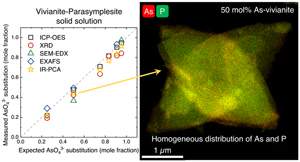 | Vivianite-parasymplesite solid solution: A sink for arsenic in ferruginous environments? Abstract: Vivianite, a hydrated ferrous phosphate [FeII3(PO4)2 · 8 H2O] that forms in oxygen-poor, but Fe2+-rich conditions is important in nutrient cycling in anoxic environments. In natural vivianites, isomorphic substitution of divalent cations for structural Fe(II) are typical. However, anion substitution is rare; in particular, arsenate (AsVO43−) substitution has never been documented in natural vivianites. Only partial substitution has been reported in synthetic analogues, and parasymplesite [FeII3(AsO4)2 · 8 H2O], the arsenic end member of the vivianite mineral group, is found in hydrothermal deposits. In this study, we detail structural changes in synthesised As-vivianites (FeII3[(PO4)1−x(AsO4)x]2 · 8 H2O) with systematically increased degrees of As(V) substitution (0.22 ≤ x ≤ 0.95). As(V) was successfully incorporated into the vivianite crystal structure, creating a homogenous, solid solution between AsVO43− and PO43−. Like both end members, the intermediate As-vivianites crystallised in the monoclinic system (C2/m space group), and retained the platelet crystal habit of As-free vivianite, even at the highest As(V) substitution. This uniform incorporation of As(V), and its replacement of PO43−, provides a potentially stable sink for arsenic in anoxic soils and sediments, and may have implications in ferruginous early Earth oceans. |
<< Previous issueNext issue >>





